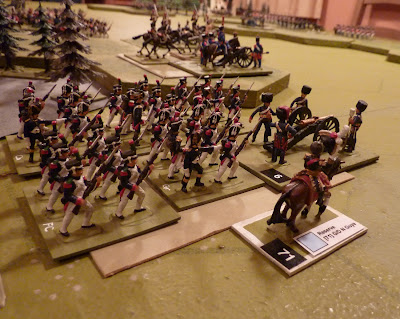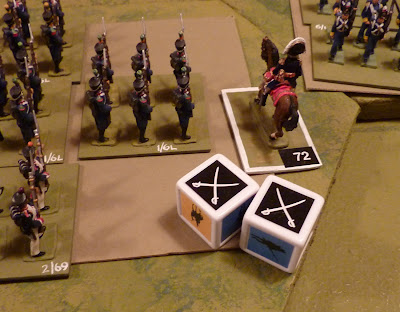It took a few days to get round to fighting this battle, so I've fallen behind the real-time calendar, not that it matters, and in any case I should be able to make up time during non-fighting weeks.
[Preamble – rules and suchlike. Even with detached forces, for this action the French army would require over 40 leaders and units in a conventional CCN game, and the Allies not much less. It is clear (to me, anyway) that such a game would be unplayable, so I used my own Grand Tactical tweaked version of CCN – first time in anger. It worked well enough, though initially it feels conceptually strange, and there are still points to be cleared up concerning the use of artillery batteries attached to infantry or cavalry brigades. Nothing arose which could not be decided as I went along, though I took a couple of notes for possible future changes – again, details only. In this amended form, the big differences in the game are that the “units” in the game become brigades, and there is no musketry fire – the game scale is reduced (increased?) to the point where musketry becomes part of melee combat. The only “ranged combat” is thus artillery fire, and the effect is greatly reduced, with batteries smaller and ranges reduced to fit the ground scale.
5 Command Cards each side, French move first throughout, 8 Victory Banners for the win.]
Narrative: Wellington, having left the Sixth Divn and much of his cavalry to cover the crossings on the Duero, marched the remainder of his army into the Leon area, to threaten Marmont’s flank and his communications through Burgos. Marmont, still with his hand forced by orders from Paris to take an aggressive stance rather than leave Castile, moved to intercept the Anglo-Portuguese army. He also left behind part of his force, under Clauzel, to cover the Duero. The pickets of the two armies made contact on the road from Salamanca to Leon, some miles north of Benavente, during the night of 27th February.
In the early morning of the 28th, Marmont found that the Allies had a fairly strong defensive position near the village of Villa Quejida, with their left flank in woods, on the bank of the (unfordable) River Esla.
Marmont had Foy’s Division from the Armee de Portugal, part of D’Armagnac’s Division from the Armee du Centre (comprising Chasse’s German brigade and St Paul’s Italians) and Guye’s Division, also from the Armee du Centre (comprising Merlin’s brigade of King Joseph’s Guard and Casapalacios’ brigade of King Joseph’s Spanish line troops). His cavalry was organised into 4 strong brigades under Montbrun, the heavy cavalry brigades commended by Pierre Boyer and Treillard, and the light by Maupoint and Curto.
Wellington, inferior in both cavalry and artillery, took a reverse slope position on the hill which dominated the area, with the Foot Guards brigade placed on an outlying hill on the right, with the artillery of the First Division. The centre was held by the brigades of Blantyre and Low from First Division, and by Halkett’s and Bernewitz’ brigades from Seventh Divn, these last two brigades being his only available designated light infantry. The lower ground near the river was held by Picton’s Third Division. The two small cavalry brigades were placed in the rear of the right flank (Anson’s light dragoons) and the centre (Bock’s KGL dragoons).
The fighting was hectic and possession of the ridge swung back and forth a few times, but the story of the battle is simply told; Marmont made early use of a Bayonet Charge Command card, and made a massive attack in the centre. The Italian brigade suffered severe losses and broke fairly quickly, but Foy’s two brigades forced their way onto the higher ground. General Picton himself brought Palmeirim’s Portuguese brigade up, after they had been delayed by Command card difficulties, and succeeded in pushing Foy’s troops back. At this point Foy received a bayonet wound in his thigh while leading the 6eme Leger, of Chemineau’s brigade, and was taken to the rear.
By this stage, the Allied infantry on the ridge were exhausted, and Foy’s men took a measure of revenge for the loss of their leader, rallying and regaining the ridge. A critical moment came when the valiant Portuguese finally gave way, Picton being seriously wounded as he attempted to rally them. On the Allied right, things were also going badly, as the Foot Guards, though in square, were broken by Treillard’s heavy cavalry, led with great courage and extraordinarily lucky dice rolls by Montbrun (in his new “Lasalle” guise). Treillard’s men, encouraged (not to say surprised) by this success, rushed on to press home a Bonus Combat (as defined in CCN), swept away Anson’s light dragoons and overran Gardiner’s foot battery. With the loss of Picton, the French now had a margin in Victory Banners of 9-4, and the day was won, the margin being officially Decisive.
OOBs
French Army – Marshal Auguste Marmont, Duc de Raguse
Gen de Divn MS Foy (w)
Brigade Chemineau – 6e leger & 69e ligne (5 bns in total)
Brigade Desgraviers – 39e & 76e Ligne (4 bns)
1 horse battery
1 foot battery
Gen de Divn D’Armagnac
Brigade Chasse – Regt de Prusse, 3e Berg, 4e Hesse-Darmstadt (4 bns)
Brigade St Paul (Italians) – 2e leger, 3e & 5e ligne (5 bns)
1 Italian foot battery
Gen de Divn N Guye
Brigade Merlin (King’s Guard) – Grenadiers, Fusiliers & Voltigeurs (5 bns)
Brigade Casapacios (Spanish) – Castilla, Toledo, Royal Etranger (4 bns)
1 horse battery (King’s Guard)
Gen de Divn Montbrun
Brigade Boyer – 15e & 25 Dragons
Brigade Curto – 3e Hussards, 13e, 22e & 26e Chasseurs a Cheval
Brigade Treillard – 13e Cuirassiers, 4e Dgns, Dragoni Napoleone, Vistula Lancers
Brigade Maupoint – 1st & 2nd Pommerian ChevauxLegers, 5e Chev-Lanciers
1 horse battery
Total 28240 men with 34 guns – loss approx 6040 men and 2 guns
Allied Army – Earl of Wellington
First Divn (Sir Thomas Graham)
Henry Campbell’s brigade – Coldstream & 3rd Foot Guards
Blantyre’s brigade – 2/24th, 1/42nd, 2/58th & 1/79th Foot
Von Low’s brigade – 1st, 2nd & 5th Bns KGL
1 foot battery
Third Divn (Sir Thomas Picton (w))
Wallace’s brigade – 1/45th, 74th & 88th Foot
John Campbell’s brigade – 2/5th, 2/83rd & 94th Foot
Palmeirim’s (Portuguese) bde – 9th & 21st Regts (2 bns each) & 11th Cacadores
1 foot battery
Seventh Divn (part) (Sir John Hope)
Halkett’s brigade – 1st & 2nd Light bns, KGL & Brunswick-Oels jaegers
Bernewitz’s brigade – 51st & 68th Foot & Chasseurs Britanniques
1 horse battery
Cavalry (George Anson)
Anson’s brigade – 11th, 14th & 16th Light Dgns
Von Bock’s brigade – 1st & 2nd dragoons, KGL
Total 23300 men with 18 guns – loss approx 7490 men and 4 guns
Both armies heavily disorganised by the action – Allies retreated towards Lugo (which is a rough road) – French remained on the field to look after their wounded and reorganise. The Allied retreat may give rise to Demoralisation, since the roads are bad, weather is still wintery, and the army is defeated and tired to start with. Will assess this in next week’s returns.
Allied position at the start, seen from their right
...and the French, from their left
Nicolas Guye, with King Joseph's Guard - the small brigades took a bit of getting used to
Foy leads the main attack in the centre
The French attack, seen from behind the Allied position
The French move quickly to seize the initiative, thanks to favourable Command cards
Montbrun sets about the British Foot Guards on the hillock
The Allies' last hope - Picton brings in the Portuguese brigade (right side of picture)
Ouch! - MS Foy is wounded - still brings tears to my eyes thinking of it










Poor Foy.......poor you!!! But is it fatal???? Great report!
ReplyDeleteThis is nothing, mon ami. [The real Foy received his 15th significant wound near Hougoumont on the Waterloo battlefield - he could have got a job as a tea-strainer if he hadn't gone into politics.]
ReplyDeleteI admit that I have cancelled my entry in the Armee de Portugal break-dancing competition next week.
Bonne chance - MSF
Small brigades? try Napoleon's Battles with its 1/120 men scale!
ReplyDeleteRegards
Rafa
Hi Rafa - really interesting - CCN needed too many units, my GT version probably didn't need enough - I need something in between! the CCN people (GMT) reckon you can handle any size battle with CCN, but I'm not so sure...
DeleteRegards - Tony
Uh Oh, No Marquess this year!
ReplyDeleteHi Ross - yes - bit of a reverse here. In fact, AW's titles are always a problem for me, so I checked it out again (as oft before). Apparently he was created Earl of Wellington on 28th Feb 1812 - the actual day of Benavente! - hmmm. The title of Marquess was bestowed (what kind of a verb is that? - I bestow, thou bestowest, he bestoweth...) in August 1812, in recognition of Salamanca. I didn't know that - probably everyone else on the planet did. If anyone had asked me whether a Marquess outranked an Earl I'd probably have got it wrong. One of the Random Events the Allies have to put up with in my game is political interference, and I mean from Westminster, not Lisbon or Madrid. The real Wesley/Wellesley/Wellington seems to have spent a huge proportion of his time keeping the UK government happy, or they would have pulled him out of there. So it is with the Random Events. If the wrong number comes up, then it is not a question of Old Atty being an Earl or a Marquess, it is a question of his being unemployed, or maybe governor of Jamaica. I have a scratch list of potential successors, but would be interested to hear any suggestions for who would have got the gig if they'd pulled him out.
DeleteIn fact, this is so juicy I may do a supplementary post on exactly that topic...
If I wasn't wounded I would be excited at this point - Cheers - MSF (Tony)